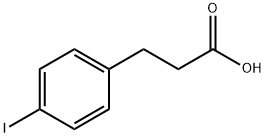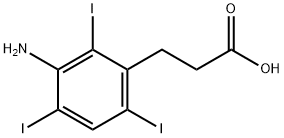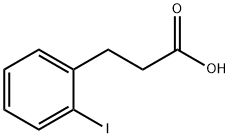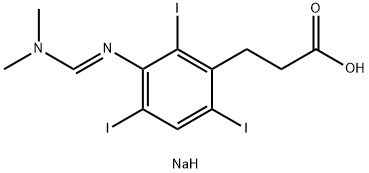3-[[(dimethylamino)methylene]amino]-3-(2,4,6-triiodophenyl)propionic acid
- CAS NO.:5587-89-3
- Empirical Formula: C12H13I3N2O2
- Molecular Weight: 597.96
- MDL number: MFCD16885721
- EINECS: 226-992-7
- SAFETY DATA SHEET (SDS)
- Update Date: 2024-08-01 13:52:05
![3-[[(dimethylamino)methylene]amino]-3-(2,4,6-triiodophenyl)propionic acid Structural](https://img.chemicalbook.in/CAS/GIF/5587-89-3.gif)
What is 3-[[(dimethylamino)methylene]amino]-3-(2,4,6-triiodophenyl)propionic acid?
Absorption
The lipophilicity of ipodate is sufficient for passage through the gastrointestinal mucosa. After ingestion, iopodic acid is promptly absorbed by passive diffusion in the small intestinal mucosa. The presence of bile salts in the duodenum is essential for its diffusion through the intestine wall and a high-fat diet is important in order to increase the absorption effectivity. The maximum effect is showed to be attained 5 hours after the initial dosage and the effect were retained for more than 60 hours.
Toxicity
Iopodic acid is cathegorized as one of the top 10 linked to skin reactions.
The Uses of 3-[[(dimethylamino)methylene]amino]-3-(2,4,6-triiodophenyl)propionic acid
Diagnostic aid (radiopaque medium).
Background
Iopodic acid, also known by the name of ipodate, is classified as a cholecystographic agent formed by a weak organic acid that contains a tri-iodinated benzene ring with iodine at positions 2, 4 and 6. Due to its particular structure, it presents a high degree of lipid solubility and a radiopaque property. It was developed and filed to the FDA by the company BRACCO. This drug was approved on March 15, 1962 but it is nowadays discontinued from the FDA and Health Canada. On September 22, 1981, ipodate was submitted again by the company Schering AG but it is currently under an inactive status.
Indications
Iopodic acid is available as a cholecystographic agent. This denomination indicates the iopodic acid is a radiopaque substance that can be used to visualize the gallbladder and biliary channels in abdominal X-ray. An abdominal X-ray uses a minimal amount of ionizing radiation to produce pictures of the inside of the abdominal cavity. It is commonly used to evaluate the stomach, liver, intestines, and spleen.
Iopodic acid has also been indicated for the treatment of hyperthyroidism such as Graves disease. Hyperthyroidism refers to any condition where there is too much thyroid hormone produced in the body (overactive thyroid). When the overactivity involves the entire thyroid gland, it is known as Grave's disease.
Definition
ChEBI: Iopodic acid is a monocarboxylic acid.
brand name
Oragrafin Calcium(Bracco).
Pharmacokinetics
The thyroid effects of iopodic acid are related to the blocking of the more potent form of the thyroid hormone. It also blocks thyroid hormone release and it can interfere with its synthesis in some patients. The effects of iopopdic acid on some diseases, such as Graves disease, have been shown not to be as effective and to present a relapse after discontinuation. The effects of iopodic acid on thyroid has been proven to produce an inactivation of approximately 80% of the type II deiodinase in pituitary and cerebral cortex.
Metabolism
The absence of a substituent at position 5 facilitates for preferential hepatocyte uptake. Once taken in the liver, the metabolism is mainly performed by glucuronide conjugation in the same pathway as bilirubin.
Properties of 3-[[(dimethylamino)methylene]amino]-3-(2,4,6-triiodophenyl)propionic acid
| Melting point: | 168-169° (dec 225°) |
| Boiling point: | 579.8±60.0 °C(Predicted) |
| Density | 2.2000 (rough estimate) |
| refractive index | 1.7400 (estimate) |
| pka | 5-5.5(at 25℃) |
| Water Solubility | 1.81g/L(temperature not stated) |
Safety information for 3-[[(dimethylamino)methylene]amino]-3-(2,4,6-triiodophenyl)propionic acid
Computed Descriptors for 3-[[(dimethylamino)methylene]amino]-3-(2,4,6-triiodophenyl)propionic acid
New Products
Tert-butyl bis(2-chloroethyl)carbamate 4-Methylphenylacetic acid N-Boc-D-alaninol N-BOC-D/L-ALANINOL N-octanoyl benzotriazole 3-Morpholino-1-(4-nitrophenyl)-5,6-dihydropyridin- 2(1H)-one Furan-2,5-Dicarboxylic Acid DIETHYL AMINOMALONATE HYDROCHLORIDE 1,1’-CARBONYLDIIMIDAZOLE R-2-BENZYLOXY PROPIONIC ACID 1,1’-CARBONYLDI (1,2-4 TRIAZOLE) N-METHYL INDAZOLE-3-CARBOXYLIC ACID (2-Hydroxyphenyl)acetonitrile 4-Bromopyrazole 5-BROMO-2CYANO PYRIDINE 5,6-Dimethoxyindanone 5-broMo-2-chloro-N-cyclopentylpyriMidin-4-aMine 2-(Cyanocyclohexyl)acetic acid 4-methoxy-3,5-dinitropyridine 1-(4-(aminomethyl)benzyl)urea hydrochloride 2-aminopropyl benzoate hydrochloride diethyl 2-(2-((tertbutoxycarbonyl)amino) ethyl)malonate tert-butyl 4- (ureidomethyl)benzylcarbamate Ethyl-2-chloro((4-methoxyphenyl)hydrazono)acetateRelated products of tetrahydrofuran
![3-[[(dimethylamino)methylene]amino]-3-(2,4,6-triiodophenyl)propionic acid](https://img.chemicalbook.in/CAS/GIF/5587-89-3.gif)





You may like
-
 2033-24-1 98%View Details
2033-24-1 98%View Details
2033-24-1 -
 1975-50-4 98%View Details
1975-50-4 98%View Details
1975-50-4 -
 2-HYDROXY BENZYL ALCOHOL 98%View Details
2-HYDROXY BENZYL ALCOHOL 98%View Details
90-01-7 -
 2-Chloro-1,3-Bis(Dimethylamino)Trimethinium Hexafluorophosphate 221615-75-4 98%View Details
2-Chloro-1,3-Bis(Dimethylamino)Trimethinium Hexafluorophosphate 221615-75-4 98%View Details
221615-75-4 -
 61397-56-6 CIS BROMO BENZOATE 98%View Details
61397-56-6 CIS BROMO BENZOATE 98%View Details
61397-56-6 -
 14714-50-2 (2-Hydroxyphenyl)acetonitrile 98+View Details
14714-50-2 (2-Hydroxyphenyl)acetonitrile 98+View Details
14714-50-2 -
 118753-70-1 98+View Details
118753-70-1 98+View Details
118753-70-1 -
 733039-20-8 5-broMo-2-chloro-N-cyclopentylpyriMidin-4-aMine 98+View Details
733039-20-8 5-broMo-2-chloro-N-cyclopentylpyriMidin-4-aMine 98+View Details
733039-20-8